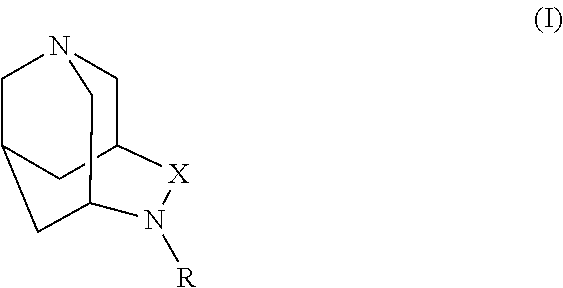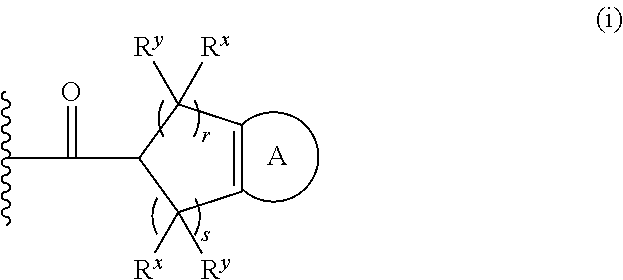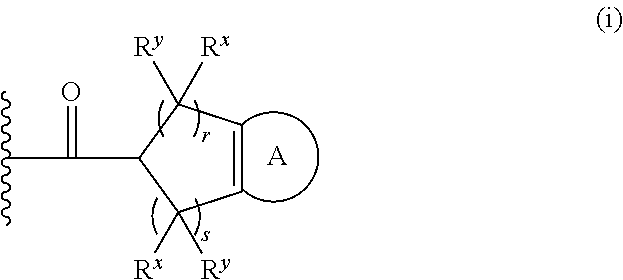Diazahomoadamantane derivatives and methods of use thereof
a technology of diazahomoadamantane and derivatives, which is applied in the field of diazahomoadamantane derivatives, can solve the problems of insufficient methods and treatment options of such indications, the site becomes a source of ongoing pain and tenderness, and the adverse effects of nicotine also
- Summary
- Abstract
- Description
- Claims
- Application Information
AI Technical Summary
Benefits of technology
Problems solved by technology
Method used
Image
Examples
example 1
1,4-diazatricyclo[4.3.1.13,8]undecan-5-one
example 1a
1,4-diazatricyclo[4.3.1.13,8]undecan-5-one
[0339]A solution of azaadamantan-4-one (2.0 g, 13.2 mmol; Synthesis 1992, 1080) in formic acid (10 mL) at room temperature was treated with a solution of hydroxylamine-O-sulfonic acid (2.24 g, 19.8 mmol; Aldrich) in formic acid (7 mL) added dropwise. The resulting mixture was then heated at reflux for 3.5 hours. After cooling the reaction mixture to room temperature, the solvent was removed under reduced pressure, and the resulting oil was diluted with 1 NNaOH and extracted with chloroform (3×). The combined organic extracts were washed with brine, dried (Na2SO4), filtered, and concentrated. The crude material was purified by flash chromatography over silica gel (115 g), eluting with 5-10% methanol (containing 1% ammonium hydroxide)-chloroform to afford the title compound: MS (DCI / NH3) m / z 167 (M+H)+, 184 (M+NH4)+.
example 1b
1,4-diazatricyclo[4.3.1.13,8]undecan-5-one 4-methylbenzenesulfonate
[0340]The product of Example 1A (0.25 g, 15 mmol) was dissolved in ethyl acetate (12 mL) and ethanol (1 mL) at room temperature. A solution of p-toluenesulfonic acid monohydrate (0.29 g, 1.5 mmol; Aldrich) in ethyl acetate (2 mL) was added and the mixture was stirred for 2 hours. The resulting solid was collected by filtration, washed sequentially with ethyl acetate and ether, and dried overnight at 110° C. under high vacuum to afford the title compound: 1H NMR (300 MHz, CD3OD) δ ppm 1.93-2.08 (m, 2 H) 2.18-2.34 (m, 3 H) 2.37 (s, 3 H) 2.83 (s, 1 H) 3.52 (t, J=13.1 Hz, 2 H) 3.66 (s, 3 H) 3.68-3.80 (m, 2 H) 3.85 (s, 1 H) 7.23 (d, J=8.1 Hz, 2 H) 7.70 (d, J=8.1 Hz, 2 H); MS (DCI / NH3) m / z 167 (M+H)+, 184 (M+NH4)+.
PUM
 Login to View More
Login to View More Abstract
Description
Claims
Application Information
 Login to View More
Login to View More - R&D
- Intellectual Property
- Life Sciences
- Materials
- Tech Scout
- Unparalleled Data Quality
- Higher Quality Content
- 60% Fewer Hallucinations
Browse by: Latest US Patents, China's latest patents, Technical Efficacy Thesaurus, Application Domain, Technology Topic, Popular Technical Reports.
© 2025 PatSnap. All rights reserved.Legal|Privacy policy|Modern Slavery Act Transparency Statement|Sitemap|About US| Contact US: help@patsnap.com



